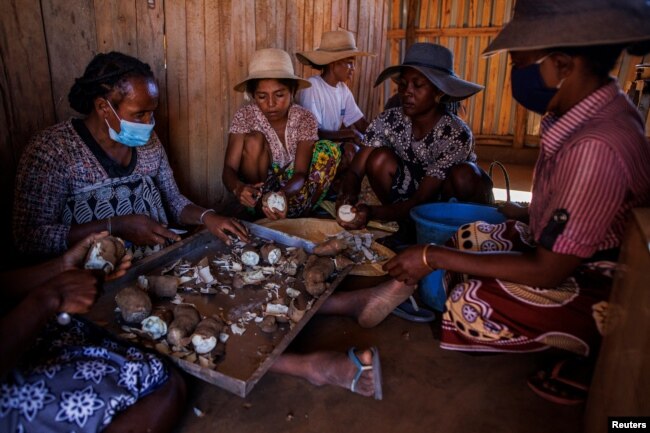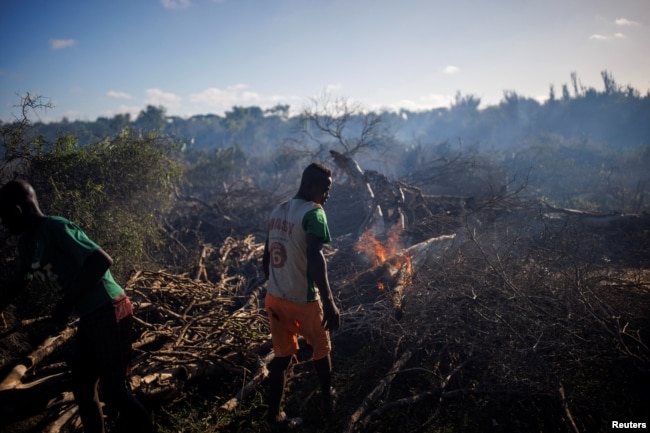緑の楽園、その南部の姿は・・・
観光案内からは想像もできない南部の現状に驚きます。
環境問題だけではないのでしょうが、このような地域は世界中に広がっておりWFPの力だけでは如何ともし難いと感じます。
VOAで英語を学び、世界の今を見つめましょう!!
マダガスカル:緑の島が赤に染まる(和訳)
Madagascar: a Green Island Turns Red
March 20, 2022
風を弱める木がほとんどないマダガスカル南部では、砂が吹き荒れ続けています。砂は畑や村、道路に降り積もり、食糧支援を待つ飢えた子どもたちの目にも入ります。
4年にわたる極度の乾燥と、農地を作るための森林伐採により、かつて肥沃だったこの地域は埃っぽい赤い空虚な土地に変わってしまったのです。
「収穫するものがありません。だから私たちは食べるものがなく、飢えているのです。」とタリラさんは言います。7人の母親である彼女は、アンジェッキー・ビーンタラ近くの世界食糧計画(WFP)センターで待っていました。彼女は、飢餓に苦しむ子供たちに提供されるピーナッツベースの濃厚な食品であるプランピーを受け取るためにそこにいたのです。国連機関によると、マダガスカル南部では現在100万人以上がWFPの支援を必要としているとのことです。
4歳の息子、アボラザ君の細い腕を抱きながら、「7人いるから、食べ物が足りなかったのよ。プランピーでは足りなかったの。 」と彼女は話します。
この地域の他の多くの人々と同じように、タリラさんと彼女の家族も、ラケタという地元の植物を食べることがありました。この植物は野生で育つが、貴重な栄養素はほとんど得られないと彼女は言い、食べると腹痛を起こすこともあると付け加えます。
マダガスカルは地球上で4番目に大きな島で、地球上で最も多様な生態系を持つ国の一つです。色とりどりの植物や野生動物が何千種も生息しています。しかし、すべてが自然で緑豊かな楽園というわけではありません。特に南部では、島の環境の実態が変わってきているのです。
「かつてマダガスカルは緑の島と呼ばれていましたが、悲しいことに今はむしろ赤い島です。」と、南部アンドロイ地区のソジャ・ラヒマロ・チマンディラツェ知事は言います。
雨を祈る
マダガスカル南部の食糧危機は、数年かけて拡大しました。政府関係者や援助団体は、干ばつ、森林伐採、その他の環境破壊、貧困、COVID-19、人口増加など、さまざまな原因を指摘しています。
マダガスカルは3,000万人の人口を擁する、昔から異常気象の多い国でした。しかし、科学者によれば、気候変動とその急激な気温上昇が状況を急速に悪化させているとのことです。
南部の食糧危機の最中、WFPはこの島が”世界初の気候変動による飢饉”に見舞われる危険性があると警告しました。
セオドア・ムバイネッセム氏はマダガスカル南部でWFPの事業を運営しています。彼は、もはや通常の気象パターンは存在しないと述べています。村人たちはもはや作付けや収穫に最適な時期を予測することができません。
WFPや他の援助団体、地元政府は、食糧危機を抑えるために努力してきたと言います。子どもの深刻な栄養失調は、数カ月前の約30%から、現在は約5%に減少していると言います。
「村々を見渡すと、子どもたちが右往左往しています。以前はそうではありませんでした。」と彼は言います。
現在、地元では、海岸沿いの町フォーキャップの砂丘を保護する取り組みなど、将来を見据えたプロジェクトが行われています。
しかし、貧困にあえぐ農村部では、危機が拡大しています。フェリックス・フィティアヴァンソアさんは、農業を始めるために雑木林を焼き払っていました。彼と新妻は食べていかなければなりません。彼の一番の心配は、やっと雨が降って農業を始められるかどうかでした。
「雨が降らなかったら、どうしよう。神に祈るしかない」と彼は言います。
Madagascar: a Green Island Turns Red
Tarira and her son Avoraza, 4, walk through a field covered with red sand in Anjeky Beanatara, Androy area, Madagascar, February 11, 2022. (REUTERS/Alkis Konstantinidis )
With few trees left to slow the wind in southern Madagascar, sand blows continuously. It settles across fields, villages, roads and in the eyes of hungry children waiting for food aid.
Four years of extremely dry weather and forest clearing to make farmland have turned the once fertile area into a dusty red emptiness.
"There's nothing to harvest. That's why we have nothing to eat and we're starving," said Tarira. The mother of seven waited at the World Food Program (WFP) center near Anjeky Beanatara. She was there to get Plumpy, a dense peanut-based food provided to starving children. The UN agency said more than a million people in southern Madagascar currently need help from the WFP.
Holding her four-year-old son Avoraza by his thin arm, she said, "There are seven, so there wasn't enough food. The Plumpy wasn't enough for him.”
Like many others in the area, Tarira and her family have sometimes eaten a local plant called raketa. The plant grows in the wild but provides few valuable nutrients, she said, adding that eating it can cause stomach pain.
Madagascar is the fourth-largest island on Earth and it contains one of the planet’s most diverse ecosystems. It has thousands of species of colorful plants and wild animals. But, it is not all a natural, green paradise. Especially in the south, the environmental reality on the island has changed.
"We used to call Madagascar the green island, but sadly now it is more of a red island," said Soja Lahimaro Tsimandilatse, governor of the southern Androy area.
Praying for rain
The food crisis in southern Madagascar grew over several years. Officials and aid organizations point to a mix of causes: drought, deforestation, other environmental damage, as well as poverty, COVID-19 and population growth.
Madagascar is home to 30 million people. It has always been a place of extreme weather. But scientists say climate change and its fast-increasing temperatures are worsening the situation quickly.
At the height of the food crisis in the south, the WFP warned the island was at risk of seeing "the world's first climate change famine."
Theodore Mbainaissem runs WFP operations in southern Madagascar. He said there are no usual weather patterns any longer. Villagers can no longer predict the best time to plant or harvest.
He said the WFP, other aid organizations and local government have worked to limit the food crisis. He said severe malnutrition among children had dropped from about 30 percent a few months ago to about 5 percent now.
"When you look in the villages, you see children running left and right. That wasn't the case before," he said.
Local communities are now working on forward-looking projects like an effort to protect hills of sand along the coastal town of Faux Cap.
But in rural areas where people live in poverty, the crisis grows. Felix Fitiavantsoa was burning down a wooded area to start farming. He and his new wife had to eat. His main worry was whether it would finally rain so he could get started.
"If there's no rain, I don't know what we'll do. We'll pray to God," he said.
Words in This Story
diverse - adj. different from each other
species - n. a group of plants or animals that are similar
drought - n. a long period with little or no rain
pattern - n. a regular and repeated way in which something happens
マダカスカル島
www.his-j.com
アフリカ東海岸のインド洋に浮かぶ、日本の約1.6倍の面積を持つ世界第4位の大きさの島、マダガスカル共和国。島に生息する動植物の約8割がマダガスカルのみに生息する固有種であるという、
特異な生態系を持っています。そのため、島内には複数の自然保護区が存在し、この特異な生態系を守っています。
保護区ではワオキツネザルをはじめとするサルの仲間や、カメレオンなどの爬虫類といったマダガスカル島の住人たちと間近に触れ合うことも可能です。ナイトウォークなど、夜行性の動物たちの生態を観察できるサファリイベントもあり、子供にも人気。何といっても「星の王子様」に登場するバオバブの並木道の絶景は、マダガスカルに訪れる旅行者を魅了してやみません。


